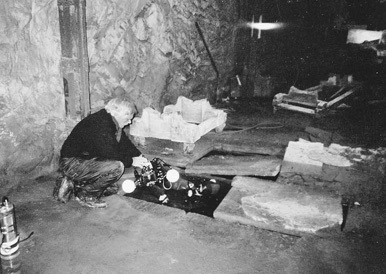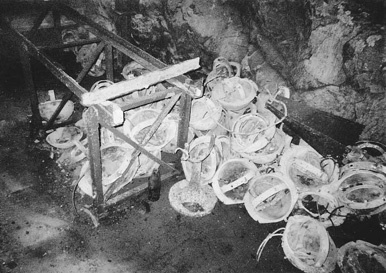No one got out of the Lancaster that we’re approaching. One of our German guides tells us that this bomber came in burning, hit the shallow lagoon and cartwheeled as it exploded into pieces. Some of these pieces are sticking up out of the ice. Willi Kramer and I identify one as part of the tail of the Lancaster. Lying flat on the ice and wiping it with our gloved hands, we can make out the tail fins and the unmistakable outline of holes punched by cannon fire through the metal. John Davis and Mike Fletcher, meanwhile, outline and then start cutting a hole through the ice as Warren Fletcher gears up and prepares the video cameras. The ice proves to be 6 inches thick. After John finishes cutting the hole, both Fletchers drop into the icy water but find themselves only chest deep. This is a shallow, muddy pond. Dropping down, wedged between mud and ice, they slowly survey the wrecked aircraft as we stand on the ice above their blurred outlines and the tracks of their bubbles that form beneath our feet.
Much of the plane is remarkably well preserved, albeit broken. The crew did not make it out, but the Germans recovered their bodies and buried them. What Mike and Warren find is battle-torn aluminum, original paint and what appears to be the barrels of the tail gunner’s machine gun, stuck fast in the mud, as Warren squeezes inside the tail section. Cold, constricted and seemingly frozen in time as well as into the ice, the downed Lancaster is a shallow but difficult dive into the past. It is also a fitting introduction to the dives that await all of us at Dora.
Our long trek into Dora’s depths takes us to a side tunnel and to the half-flooded Gallery 44, where starving inmates built V-1 rockets. Not only is the gallery flooded, but its upper level, supported by steel beams and a concrete floor, has collapsed into the water. Our lights pick out the shapes of broken slabs and half-crushed rockets beneath the water, which lies one to nine feet deep over the mounded debris along the flooded, 30-foot wide, 500-foot-long gallery. The far end is sealed off, buried by a cascade of rock when the ceiling collapsed. The water is cold and has a sharp metallic smell. A faint scum of rust and oil slicks the surface.
I’m glad that I am sitting this dive out, watching Mike and Warren as they suit up to take an hour-long snorkel, floating along the surface to film what lies below them. The flooded gallery is so filled with silt and rust that we are keeping our presence in the water to a minimum to avoid stirring it up so the divers can capture the best images possible. The cameras record stacks of V-1 wings and rocket bodies and a stack of gyrocompasses that would have been assembled in the noses of rockets to guide them to their targets. Tumbled workbenches and tables, equipment, and signs painted on machines and walls — warnings to do not touch this and to go in that direction — show not only the assembly line but a little of what life was like here.

We have time for only one other dive, this one in a flooded chamber. It’s my turn to join Mike and Warren, and I quickly dress in the half-darkness, pulling on a thick fleece undergarment and the dense shell of my dry suit. The rubber seals at my throat and wrists will close the suit off from the freezing water. I pull on my weight belt and tank, rigging my equipment tightly against my body to keep the hoses from dragging or catching once I’m inside the tight confines of the flooded room. A neoprene hood leaves only part of my face exposed, and my breath fogs and clouds the inside of my face mask. I’m already chilled as I gear up next to a black mold-covered, slimy piece of canvas that once curtained off this gallery as workers painted V-1 rocket bodies. My natural instinct is to not want to touch anything.
Mike and Warren go first, disappearing through a hole and into the darkness. I follow, feet first. The cold, even through the suit, is a shock. John Davis watches from above, and on my last glimpse of him through the oil-slicked surface of the hole, I see concern on his face. He should be worried. The three of us are entering a tight dark space that could collapse and bury us. Electric wires and lights still dangle from the ceiling, reaching out to snag us. Rust and silt, dislodged by our bubbles, filter down through the water and black out the light and our visibility. There’s only one way out, through what now seems to be a tiny hole, and leaving it behind as we work our through the murky, dark water, takes resolve.
I’m spurred on by what I see. A coffee cup sits on the top of a desk, and a book rests nearby. Drawers, some half open, are filled with tools. Paint still covers the walls, and as I gaze up at the ceiling above me, the lights still hang from their wires, with unbroken bulbs inside the metal shades. As I swim forward through this dark, flooded room, I find Mike and Warren poised at a doorway that leads into another room. The door, on a sliding track, is half closed.
Mike gently reaches out and slides the door open. Slowly and carefully, we glide inside. The room is small and crowded. Tools and equipment lie exactly where they were left by the concentration camp inmates who worked in this hellhole. Like the coffee cup and the tools in the other room, the condition of this workshop is a reminder that we’re the first to enter this space since April 1945. Due to the cold water, everything is preserved in a near deep freeze, and we feel the chill, not only of temperature but of the feeling that comes from the sense of encountering a tragic past. I can almost feel the presence of the SS and the inmates.
Our dives inside the mountain, into the flooded heart of Dora, provide a good understanding of what else may lie in other submerged chambers. The flooded rooms seem to be far better preserved than the dry portions of the tunnels, with a chance that even paper has survived — as evidenced by our spotting a book. The flooding of Dora was sudden but not catastrophic. The loss of electrical power and the shutdown of the pumps allowed the seeping water to build up and engulf the lower sections, perhaps not too long after the last of the inmates and the SS abandoned the underground workshops and factories in April 1945. Some areas may have even escaped the notice of the teams of American and later Russian searchers who scoured this complex for the secrets of the Nazi rocket program.

The Dora museum, which manages the site of the camp, with its surviving barracks building and crematorium, SS bunker and numerous foundations, as well as the 5 per cent of the underground facilities open to visitors, preserves this place as a reminder of what happened here. The focus is not on the rockets but on the people who paid the price for those incredible yet terrible technological achievements. The museum’s library is full of survivor accounts, interviews and archives about the Nazi system of camps as a means to eliminate people. After we exit the caves, we stand for a moment in the clear night air, gazing up at the swollen moon, breathing in the fresh air to cleanse the stench of Dora from our lungs and to savor the freedom of being out of those dark confined spaces.
Such is the power of a place like this, which is why we are visiting Dora to document its flooded and forgotten chambers. This place is more than a museum. It is a mirror that we must hold up to ourselves as a reminder of the worst that we as a species are capable of. As a child, I watched the astronauts with wonder when humanity first reached for the stars. I thrilled with countless others as men walked on the moon. But the roots of that triumph lie here, down in the darkness.